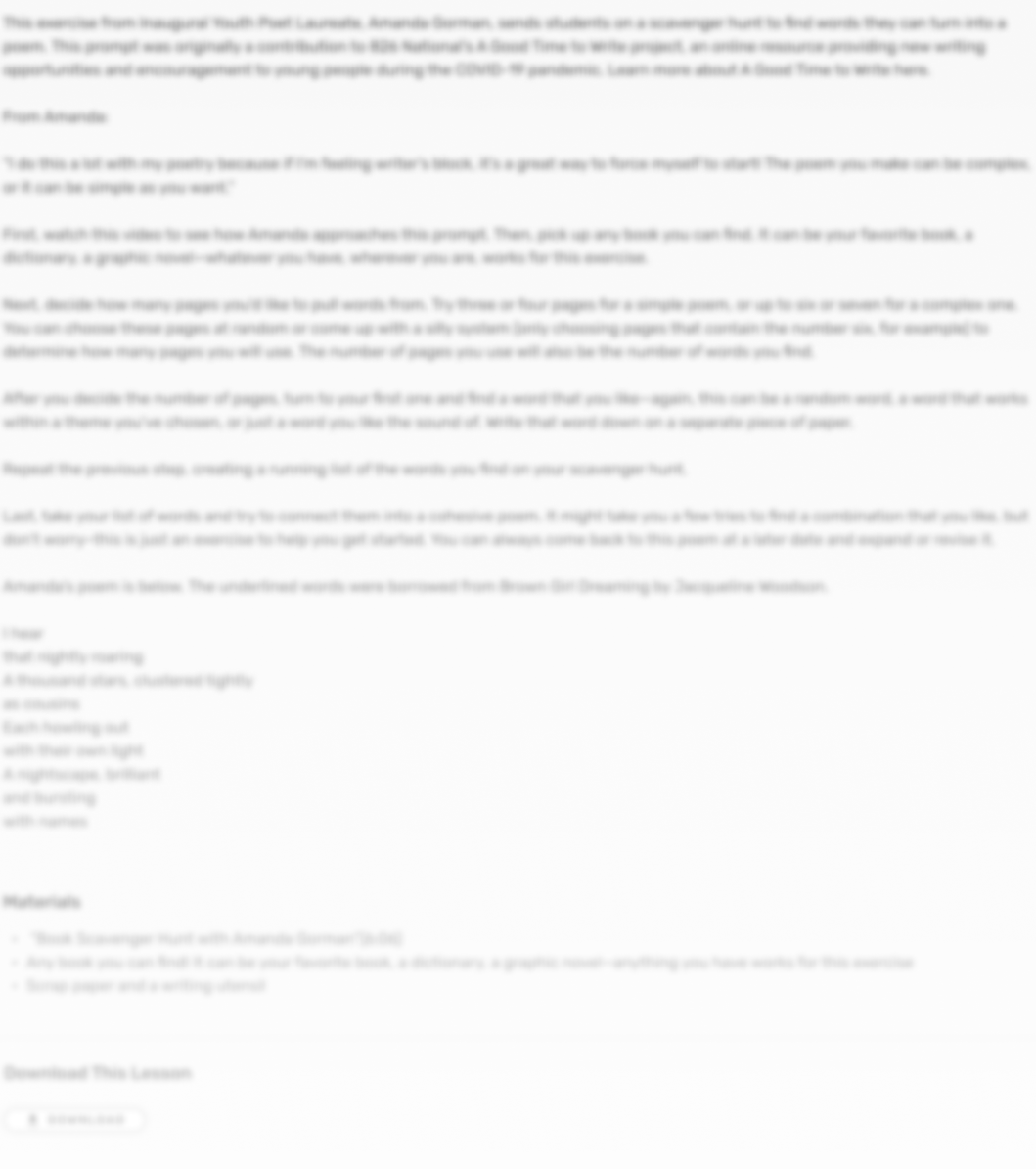 Grades 2–4
Grades 2–4 Informational
Informational Sparks
Sparks
Ashley Houston–King is a Ph.D. student at Boston University studying Language and Literacy in Education. Her research interests include studying the intersections of identities, race, and Blackness in education. As a former elementary teacher and reading specialist, she is interested in studying in-and-out-of-school humanizing literacy spaces to better understand how youth navigate injustice systems and work towards collective liberation.
Students will identify key details in reading to apply while writing an informational text.



Students will produce a short, informational piece on the life and work of young advocate Marley Dias.
Marley Dias is the visionary behind #1000BlackGirlBooks, a book drive focused on collecting books that feature women and girls of color as the protagonists. In this lesson, students will learn and write about Marley.
STEP 1
Share or present the “Marley Dias” slide deck for students. All of the resources needed to complete this lesson are included in the slide deck.
STEP 2
Discuss key vocabulary terms: representation and self-advocacy.
STEP 3
Students will learn about the life of Marley Dias through included media. As they read and watch, students should note key details about her life and work in the graphic organizer.
STEP 4
Students will finish by writing a short, informational piece about Marley Dias, including why her work is important and how she has influenced representation. Students should include key vocabulary terms in their piece.

by author Daniel Handler, a.k.a. Lemony Snicket
Students will anthropomorphize an inanimate object to produce interview questions and answers.
by 826 National and Cartoon Network
In this twist on a classic game, students will practice intentional inclusivity with their classmates, as well as brainstorm other ways to continue building community throughout the school year.
by Molly Sprayregen, 826CHI
In this social-emotional learning writing prompt, students write a poem describing the silliest creature they can imagine.
by 826 National
Engage young writers of any age at home with this collection of 826 Digital writing prompts and activities.
by Mandy Seiner, 826NYC
Nouns, adjectives, verbs—and in this case—adverbs are the building blocks of super sentences. In this Spark, students will practice identifying and using adverbs in their writing.
by Nicolien Buholzer, 826LA
Why does kindness count? Students consider acts of kindness that they’ve experienced and reflect on the difference that kindness makes in the world.
by Cristeta Boarini, 826 MSP
Author bios offer students another opportunity to express themselves through writing and to feel like a real author. This Spark walks students through the process of writing one.
by Molly Sprayregen, 826CHI
In this social-emotional learning writing prompt, students reflect on the sound of feelings and use onomatopoeias in their poetry.
by Mandy Seiner, 826NYC
Nouns, adjectives, adverbs—and in this case—verbs are the building blocks of super sentences. In this Spark, students share action words that bring them joy and incorporate those verbs into a story.
by 826 National and Cartoon Network
Students are inspired to write about a time that they felt accepted and appreciated for who they are.
by Lauren Rudewicz and David Hutcheson, 826michigan
Students will define the word “ode” for themselves and identify the people and moments in their lives they’d like to celebrate in a poem.
by 826 National
Summer is all about writing for fun! In this Spark, you’ll find a BINGO board full of engaging writing prompts to keep skills sharp over the summer break.
by Asia Calcagno, 826CHI
Writing can be a powerful tool when working through feelings of grief, sadness, or anger. This Spark creates an intentional opportunity for youth to write and speak about what is on their minds.
by the Team at 826CHI
In this activity, students create original monsters in archetypal protagonist and antagonistic roles by focusing on internal and external characteristics.
by Molly Sprayregen, 826CHI
In this collection of poetry activities, young writers will explore a range of feelings and strengthen their emotional vocabulary. Activities are available in print and web versions!
by Kathy Seipp, 826 Digital Educator
Invite students to write freely with this lesson that includes directions for students to set up a writer's journal and favorite journal prompts.
by Andrea Nelson, 826DC
In this Spark, students will develop a setting that captures the environment of an alternate world.
by 826 National, inspired by student authors of 826 New Orleans
We are all parts of a whole, just like a pizza! In this Spark, students will think about all the things that make them who they are and then write a poem in the shape of a pizza.
by Bryan Wilson, Educator Leader, Bureau of Fearless Ideas
In this lesson students will work together to revise a scene from a first draft by adding descriptive details.
by 826 National
This activity reinforces the role of dialogue in a story, with students creating realistic conversation in A-Z fashion.
by 826 National
Students will write a poem about nature using sensory details to capture the sights, sounds, smells, tastes, and feeling of the subject.
by 826 National and Cartoon Network
After writing about their personal and social identities, students discover that sometimes what makes us unique is what brings us together.
by Brittany Thierry, 826 New Orleans
In this Spark, students will write a diamante poem, using specific parts of speech to beautifully describe a topic of their choice.
by 826 National
I Spy is a classic guessing game. In this Spark, students will play a game of I Spy to practice adding details to their writing.
by 826 National and Cartoon Network
Students write similes to express what their emotions feel like and build plans to treat others with kindness and empathy.
by Jillian Wasick, 826 Valencia
What are students made of? This activity prompts students to reimagine recipes and write about their life experiences.
by Kiley McLaughlin & Dana Belott, 826 Valencia
Students experiment with alternative ways of writing poetry by reordering and rearranging pre-existing text.
by 826 New Orleans
Students will imagine what they would do if they were someone or something else.
by 826 National
The Character-O-Matic is a writing tool that helps students to create new characters. In this lesson, students will use it to create a character profile that reflects their own identies.
by Sarah Kokernot, 826CHI
Students use illustrations as entry points to write stories about friendship from a new perspective.
by Molly Sprayregen, 826CHI
In this social-emotional learning writing prompt, students help their new friend Olly the Octopus overcome his feelings of overwhelm by writing about strategies that work for them.
by Rae Baum, 826 Digital Educator Leader
This quick writing prompt invites students to jump into the fantasy genre, imagining what happens when faced with the unexplainable!
by 826 National, inspired by Julianna Lee Mariano, 826NYC
Calling all ghostbusters! In this Spark, students will learn more about what makes a spooky story and then develop their own creepy characters, with a silly twist.
by 826 National
In this Spark, students will use backward thinking to create a four-panel comic strip story using the backward problem-solving skills of software developers.
by Klariza Alvaran, 826CHI
This spark activity is designed to get your students on their feet while reinforcing the need for strong dialogue in narratives.
by 826 National, inspired by student authors of 826 New Orleans
In this Spark, students will pretend to be their favorite food and write about what that food would do on an average day.
by Molly Sprayregen, 826CHI
In this social-emotional learning writing prompt, students create a poem that shares the "happys" in their life.
by 826 National
This summer is all about writing for fun! Students will engage in a variety of writing prompts, while playing tic-tac-toe, to keep their skills sharp over summer break.
by 826 National
With a little folding and loads of creativity, students make their own zines that feature abstract recipes.
by the Team at 826CHI
Students learn to incorporate setting as a key element of a story, starting with inspiration from collages.
by Liz Levine, 826NYC
Challenge students to rewrite a classic nursery rhyme with a twist.
by Julianna Lee Marino, 826NYC
In this Spark, students put on their detective hats and sleuth out places to add more details into their writing.
by 826 National, inspired by student authors of 826 New Orleans
In this Spark, students will write a poem that engages the reader in answering the question: Can you guess this food?
by 826 National
In this Spark, students will write an acrostic poem that can be used as a tool to introduce themselves to their classmates.
by Aarti Monteiro, 826NYC
This activity explores the way emotions change how we perceive settings. Students work in groups to create descriptions of apartments based on an emotion they draw from a hat.
by 826 National
Students will identify their favorite sensory memories and transfer them to a visual heart map.
by the Team at 826CHI, with inspiration from Ryan Harty, 826michigan
In this activity, students practice analyzing a character’s internal motivations and fears and develop their own original characters.
by 826 National and Cartoon Network
Students reflect on what it feels like to stand up to bullying and write about a time when they used their voice to make a difference.


We are thrilled to have you as the newest member of our online community. Stay up-to-date on the the latest and most relevant resources, student publication opportunities, and what’s new with the 826 Digital community.
